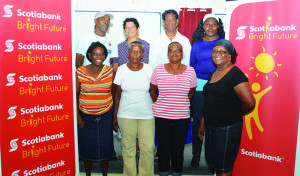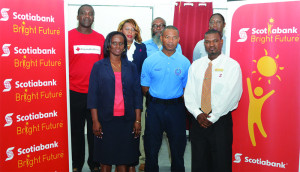

Disaster Management
Parents and guardians have now been given further assurance and peace of mind that their children will be safer in the schools with the training of teachers, ancillary staff and others, in First Aid for use in the classrooms.
The grand idea in this area of primary care was initiated by the Department of Disaster Management as part of its outreach programme – and Scotia Bank under its Bright Future Project.
The week-long training, which commenced on Monday, August 25, at the Teachers’ Resource Centre, was arranged for Primary School Teachers, Special Needs Teachers, Physical Education Teachers, Ancillary Staff and Custodians.
Mr Alwyn Richardson, Programme Officer Mitigation, with the Department of Disaster Management, said the Basic First Aid training was aimed at providing valuable information about common types of injuries and treatment. “You will learn some basic First Aid techniques that can be used in these situations,” he told the participants. “Teaching First Aid also provides an opportunity for teaching safety, prevention and risk reduction measures at the same time, as part of the first aid curriculum. A person trained in first aid is more motivated to avoid personal injury, because their training gives them a greater appreciation of the potential serious consequences.”
Mr Richardson was grateful to Scotia Bank for making the training possible.
Scotiabank’s Managing Director, Mrs Pamela Herbert-Daniel, said in part: “In today’s society, parents totally entrust their children to the schools. They rely on the teachers as their second parents in the institute for learning. Parents know for a fact that these educators will want no harm to come to their children, while they are busy working.
“Apart from teaching the academic subjects, teachers also have the responsibility to monitor their students. Parents enrol their children with the expectations that they will be comfortable and secured whether it be within the four walls of the building or on the playground. This expectation also extends to stress situations such as health issues. Therefore, the staff should be required to have some form of experience in the field of first aid training.
“Today, Scotiabank Bank Bright Future Programme supports the opportunities for you, the participants, to gain the necessary first aid knowledge and skills about risk factors for specific injuries. It must be noted that the very goal of the first aid course should not just be confined to educating teachers, but also focus on emphasing the preventive measures that can lessen the occurrence of accidents.”
Mrs Susan Smith, Education Officer, Pre/Primary Education, commended the Department of Disaster Management and Scotia Bank for the initiative. She said “it will help to make our schools safer places” for children.
“The Department of Education is pleased to benefit from the Bright Future Project, and we have given it priority as we put things in place to ensure the safety of our students,” Mrs Smith continued. “This project will result in the training of a number of staff members including Custodians, Physical Education Teachers, Special Needs Teachers, Preschool, Primary School and Secondary School Teachers. Additionally, the project will extend to our grade six students – teaching them to care for others and equipping them with skills that can be used to make a difference. Definitely, the end result of this project will be safer schools.”
Mr Valdez Johnson, Scotia Bank’s Bright Future Champion and Coordinator in Anguilla, said the initiative was not just for the Red Cross and First Aid on the islands. “If you have any project in mind that caters for children’s development, Scotia Bank’s Bright Future Project is there for you,” he stated. “I challenge you out there to think about an innovative way on some programme you can coordinate to brighten our children’s future, and we would be glad to help you.”







